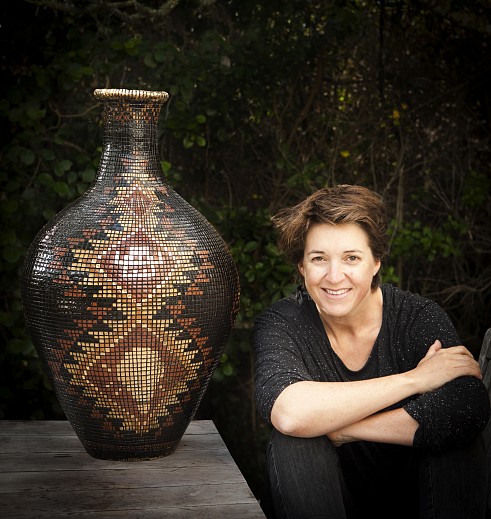
INTERVIEW: Lucinda Mudge in preparation for Against Interpretation?
May 22, 2020
INSIDE THE ARTIST’S STUDIO
Q&A with Lucinda Mudge
We’re looking at your works which will be part of a group Exhibition in London entitled Against Interpretation?
Please tell us a bit about how these works came into being – what was the starting point?
My pieces are natural developments in terms of my skill as a maker.
On a simplistic level I wanted to free up my mark making and produce pieces that had spontaneity. They are large pieces, and the mark making is bold - however on closer inspection there is a story happening, small figures trying to navigate their way up - trapped in a maze of abstraction.
The smaller piece titled ‘Lookielookie’ is covered with openings, eyeballs looking out, with sexual undertones. It alludes to a perverse spying, and yet is very alluring itself. Who is looking at who?
I have recently been digesting what it is to live the life of an artist - to be looked at. This piece looks back.
In her 1964 essay Sontag argues that reducing a work of art to its content and then interpreting that, tames the work of art. How do you feel about explaining, interpreting your work for others?
An artist always has an agenda when making an artwork. However, it is not necessary for the viewer to feel the need to understand the agenda - a viewer may interpret an artwork in any way they please.
I am happy to explain my work.
How do you prepare your ceramics? Do you make any preparatory drawings beforehand?
Do you work on one piece at a time or shift between multiple works at one time?
I collect images and phrases that I like. Then, as a vase takes shape I work depending on its size and shape. For example, a very large black vase carrying a tiny message in gold relief. Or a very small vase, with a lot of detail.
When I am building the vases, I do not control size or shape, preferring to let the piece evolve organically. Clay tends to want to do its own thing. Once I have physically built a vase, I wrap it in plastic, and let it stand for a week.
Recently my exhibitions of vases have been centered around a theme. The last theme was Love Story, which reflected on my own tragic love story with clay, in duality with mock-sadness from failed relationships. Enjoying a breakup song on the radio.
Normally the first vase in a series will inspire the others. From then on it’s a happy game - opening the kiln, seeing what works - making another. I consider colour, form, and narrative - each vase adding a different element to the final series. This is why, when one vase cracks in the kiln, it is such a setback - as each piece was made to work with the series. I start from scratch and remake it, which takes around two months.
Some people listen to music or podcasts while they work others are absorbed in the relative silence of their studio. Please set the scene for us in your studio…
My studio is joined to the rest of our house, so I am aware of the goings on there. It is a small room with double doors opening out onto a deck surrounded by forest and bush. Sometimes a rogue baboon will run past, giving me heart failure. They are huge and intimidating and not at all afraid of women.
Sometimes the particular tweeting of birds will make me aware of our resident one-and-a-half meter long boomslang (tree snake) slithering through the bush around the back of our house. I listen to the local radio station, I like the radio shmultz. My studio is messy, and I am happy there.
What do you do when you reach an impasse; a work just isn’t coming together as you’d envisaged?
If my pieces are not that good - I smash them.
How do you know when a work is finished; what are the triggers for you?
Well, the kiln opening reveals the finished piece. It’s either finished, or it’s a failure. Nice and clean-cut.
What are some of the emotions you experience when you finish an artwork?
Pride. The journey is a long one, and I feel great satisfaction in looking at my finished pieces. I keep one piece from every exhibition and I have them lined up on the edge of our swimming pool.
Do you have a ritual when you finish a work or a body of work - cleaning your studio & starting afresh?
I try to complete my work six weeks before a solo exhibition opening. This gives me time to consider each piece and be objective about which to include.
I then photograph each piece myself, and design the exhibition catalogue with the gallery. This takes about a month, during which I am not making new pieces. It is a time to reflect and wind down. I take time out, experimenting and enjoying the variety of different mediums - oil on canvas waterfall paintings, delft tiles for our bathroom, some sculptures.
I seldom clean my studio and as a result most people would consider my studio to be a mess, however, I know where everything is, and I don't like to spend time tidying up. We have too many large spiders around and I’d rather not disturb any.
Is it bittersweet when works leave your studio or are you happy / relieved to see them go and find their place in the world?
Mournful for weeks afterwards - and only happy when the bank balance starts to look healthy again!
Download the full interview here
Back to News



